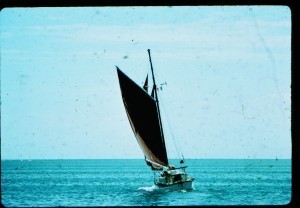My Bali Hai

Kathi II anchored next to Curlew in Cook’s Bay, Moorea
by Christine Kling
We left Papeete, Tahiti in 1975 because of the crowds. It was le quatorze juillet or French Independence Day and after the outrigger canoe racers and the fruit carrying races and the dance competitions, we were looking for some peace and quiet. We’d been in the islands long enough that Papeete was the Big City and we could only take it for so long.
So after spending a couple of weeks med-moored on the waterfront in Papeete, we picked up our anchor early one morning and set sail for the island of Moorea, a mere nine miles across the channel from Tahiti. Another problem I had with French Polynesia was the free flowing red wine, and on that short crossing I hung my head over the side and chummed the fish for the first and last time in my life.
Needless to say, when we arrived in Cook’s Bay a few hours later, I was not in top form. Although this was certainly a short trip, the entrance to the bay was narrow through a cut in the reef with breakers creaming on both sides. The trades were tooting their usual 25 knots and we had no idea what the current was doing. The French charts we had stated that they were based on surveys taken in the 1890′s. We dropped all sail and motored through the pass in the reef with me standing up on the bow keeping watch for coral heads.
We made it through the pass and found our way in to an anchorage where ours was the only boat. We dropped the hook in the shade of the high island peak and Jim rowed the anchor ashore and tied it to a coconut palm. Then it was time to clean up the boat, and what a mess it was. It took us until the next afternoon to sort out our mess of lines, sails, sail covers, awnings and anchor lines.
The next afternoon as I was just finishing up a sink full of dishes, Jim called me topsides to look at something. There charging through the reef was a gorgeous little gaff-rigged cutter with tanbark sails and everything flying charging through the reef.
“It’s Tim and Pauline,” Jim said. “They’re a Brit couple. I met them in Hawaii.”
They flew through the pass, then as they sailed into the lee of the island, the wind decreased but their little vessel carried her way, and they sailed on toward us. As they neared our boat, theirs rounded up smartly, dropped jib, staysail, gaff-rigged mainsail and in the wink of an eye all were furled, the anchor set and Tim was rowing their little cockle shell dink to wrap a line around a palm tree whilst Pauline was calling over to us, “Would you like to come over for a cup of tea?”
I was absolutely gobsmacked by this feat of seamanship, but when we rowed over, not only was their boat neat as a pin, but there was a pot of delicious homemade soup bubbling on the stove and the two brass lamps on the bulkhead were polished to a sparkling hue.
And I was pretty damn sure that Pauline had not been feeding the fish in the channel due to an over-indulgence in the holiday spirits.
I was in awe of both their seamanship and their housekeeping abilities. Their 28-foot boat CURLEW had no engine and was built in 1905 in Falmouth England, originally designed to unload ships in the harbor. The Carrs had bought her in Malta about 10 years earlier where she was cheap and in disrepair. Like us, they were driven by dreams of sailing the South Pacific. At the time we visited, their boat felt like a real home, and I yearned to have the skills to cruise as efficiently as they did.
 I never saw the Carrs again after our interlude in Cook’s Bay, but I always remembered them. They went on to become rather famous in the lore of great cruising sailors. They sailed their engineless CURLEW for 30 years, finally settling in South Georgia Island in the South Atlantic and eventually writing a book about their efforts to preserve and appreciate the environment there called Antarctic Oasis: Under the Spell of South Georgia. Today, CURLEW is in the National Maritime Museum of Cornwall which makes me feel a little like an antique, as well. But I also feel privileged to have met two of the greatest sailors of our time.
I never saw the Carrs again after our interlude in Cook’s Bay, but I always remembered them. They went on to become rather famous in the lore of great cruising sailors. They sailed their engineless CURLEW for 30 years, finally settling in South Georgia Island in the South Atlantic and eventually writing a book about their efforts to preserve and appreciate the environment there called Antarctic Oasis: Under the Spell of South Georgia. Today, CURLEW is in the National Maritime Museum of Cornwall which makes me feel a little like an antique, as well. But I also feel privileged to have met two of the greatest sailors of our time.
Still, I’ve never learned to keep my brass polished like Pauline did.
Fair winds!
Christine
Share on Facebook



